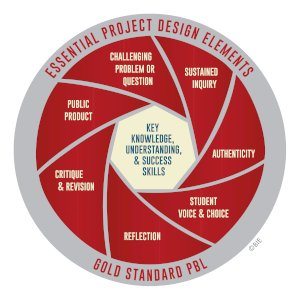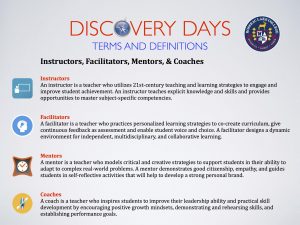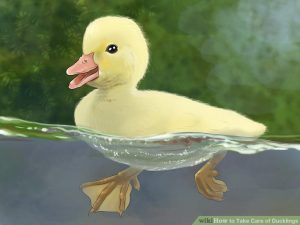FACILITATOR DEVELOPMENT
“The goal of education has changed from the transfer of knowledge to the inculcation of wisdom” (Lichtman, 2014). Teachers have recently embraced the notion that direct instruction limits the effectiveness of knowledge transmission, as all students have personalized learning styles. The idea that a teacher should no longer be a “sage on the stage”, but rather a “guide on the side”, has meant a progressive reworking in the definition and purpose of this noble profession.
To help understand the various professional roles needed for teachers at Rosseau Lake College to conduct their challenging and multifaceted jobs, the faculty brainstormed and decided on four distinct responsibilities: Instructor, Facilitator, Mentor, and Coach.
The concept of a facilitator makes sense in a highly digitized information age in which teachers support student inquiry instead of merely delivering content.
This past August, teaching faculty at RLC dove deeply into facilitator training as we engaged in a two-day intensive workshop from the Toronto-based Future Design School headed by, you guessed it, Cohort21’s very own @lmcbeth! The effectiveness of this Design Thinking (DT) course entitled, “Hack Your Curriculum” led to further developments of our new DISCOVERY DAYS model—namely the opportunity for integrated “How Might We…?” (HMW) questions across subject areas. Our new facilitation skills had its first real challenge: a new model of curriculum delivery.
INTEGRATED PROJECT-BASED LEARNING
“How Might We…?” (HMW) questions are at the heart of the Design Process, a structured inquiry method for defining and prototyping projects, based on cultivating empathy for an end user. Each HMW question leads the student on a collaborative quest to discover more specific applications for their project. At Rosseau Lake College, we call thse Discovery Projects:
The Design Thinking (DT) method, first piloted in educational use at Stanford University (IDEO Stanford Design School) is a catalyst for creative action within the larger independent Project-Based Learning (PBL) practice. The Gold Standard PBL model was developed by the Buck Institute (BIE) and outlines the key components of administering this self-learning method.
 BIE defines project-based learning as “a teaching method in which students gain knowledge and skills by working for an extended period of time to investigate and respond to an authentic, engaging and complex question, problem, or challenge” (Buck Institute for Education, 2017).
BIE defines project-based learning as “a teaching method in which students gain knowledge and skills by working for an extended period of time to investigate and respond to an authentic, engaging and complex question, problem, or challenge” (Buck Institute for Education, 2017).
In order to deliver a powerful inquiry-based program that increases student-autonomy and collaboration at every stage of the Discovery Projects, aspects of the Question Formulation Technique (QFT) as used by the Right Question Institute (RQI) are also incorporated:
- Ask as many questions as you can
- Do not stop to discuss, judge or answer the questions
- Write down every question exactly as stated
- Change any statement into a question
By focussing on questions as the driver of curiosity and learning, it is understood that students will take ownership of their Discovery Projects through voice-and-choice while building links to real-world connections through their growing reflective knowledge. This ultimate inquiry method—as frustrating as it can be to those students used to learning in more traditional rote ways—also builds resilience by promoting an open mind to differing possibilities, including the possibility of failure.
Multiple-choice tests communicate nothing about school climate, student engagement, the development of citizenship skills, student social and emotional health, or critical thinking. School quality is multidimensional.
–Jack Schneider is an assistant professor of education at the College of the Holy Cross and the director of research for the Massachusetts Consortium for Innovative Education Assessment.
Teachers at RLC saw an opportunity for DISCOVERY DAYS to develop new professional skills as facilitators. As this is a whole-school initiative and incorporates up to 30% of each student’s summative marks, why not facilitate students towards combining ideas for their Discovery Projects. Cross-curricular learning at the high school level is often difficult to organize. Subject teachers rarely teach complementary units and assessment of these projects takes extra collegial meetings that rarely happen. This is unfortunate, given how important it is for students to view all knowledge areas as vital and connected.
The key aspect of DISCOVERY DAYS is the prospect of students being able to complete one or two integrated projects instead of four separate ones.
For this first round of DISCOVERY DAYS, students chose from preselected HMW questions for each of their subjects. They were then guided by facilitators to develop partially-integrated HMW questions that combined curriculum outcomes from at least two subject areas. The bold students challenged themselves to create a fully-integrated HMW question that covered all subject expectations.
Students begin to take part in defining learning goals, connecting the learning to their own interests and aspirations and becoming more active observers and guides to their own and to their peers’ learning and progress. Deep learning tasks build upon the foundation of the new learning partnerships. They challenge students to construct knowledge and begin to use their ideas in the real world. In the process, they develop key skills and the experience of doing ‘knowledge work’ in ways that develop tenacity, grit, and the proactive dispositions that pave the way to flourishing futures. (Fullan, 2014)
Facilitation in the technology age is a relatively new professional skill that deserves more opportunities and support for teachers to practice and develop in their classrooms. Project-based learning is a natural opportunity to ask deeper questions of students and share in big ideas while fostering real-world connections. As learning becomes more autonomous and adaptive, important skillsets and mindsets such as modelling, encouragement, discernment, and inspiration become vital transmission tools for new flexible learning spaces that aren’t conducive to “chalk and talk”. Facilitation differs from regular instruction and coaching in that on the surface it looks like nothing is happening. Underneath, however…




